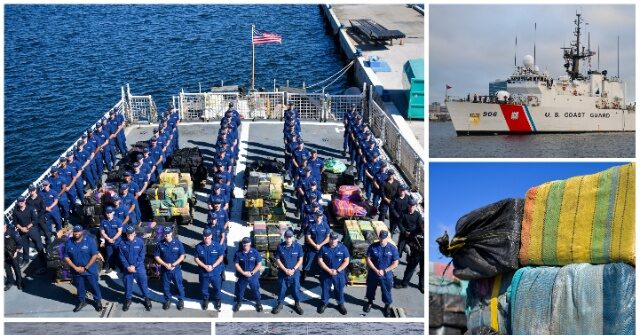Following a seizure in the Eastern Pacific Ocean, the crew of U.S. Coast Guard Cutter Seneca offloaded more than 12,750 pounds of illicit narcotics with a street value estimated to be worth more than $94 million at Port Everglades, Florida, on Tuesday. The crew also transferred 29 smugglers to federal agents for prosecution.
The seizures were part of an ongoing operation that utilizes multiple Coast Guard vessels and aircraft to interdict contraband and smugglers in international waters. Coast Guard crews working under Operation Pacific Viper, launched in early August, partner with global and interagency partners to conduct maritime narcotics interdiction operations.
Through Operation Pacific Viper, the Coast Guard is accelerating counter-drug operations in the Eastern Pacific Ocean, where the transport of illicit narcotics continues from Central and South America. The Coast Guard utilized cutters, aircraft, and tactical teams to interdict, seize, and disrupt transshipments of the cocaine and other bulk illicit drugs offloaded at Port Everglades on Tuesday.
According to a Coast Guard press release, Operation Pacific Viper has resulted in the seizure of more than 80,000 pounds of cocaine.
Captain Lee Jones, commanding officer of the Coast Guard Cutter Seneca commented on the efforts of his crew saying, “I’m incredibly proud of the teamwork and adaptability displayed by my crew and our partners during this patrol to stop illicit drug flow from entering the United States, our crews sacrifice time away from their families, and when necessary, put themselves in harm’s way to secure our borders and protect the American people.”
The Coast Guard is the United States’ lead federal maritime law enforcement agency with authority to enforce national and international laws on the high seas and waters within U.S. jurisdiction. Eighty percent of all U.S.-bound narcotics seizures occur at sea, underscoring the impact of Coast Guard maritime interdiction efforts.
Coast Guard Cutter Seneca is a 270-foot Famous-class medium endurance cutter with a crew of 100 homeported in Portsmouth, Virginia.
The narcotics seizures made by the Coast Guard and other federal agencies on the high seas have reached historic levels in recent months. As reported by Breitbart Texas, in September, United States Attorney for the District of Columbia Jeanine Pirro announced the most significant federal seizure of drug precursor chemicals by federal law enforcement authorities in U.S. history during a Wednesday press conference in Pasadena, Texas. The precursor chemicals, seized in two separate maritime interdictions, were headed from China to Mexico’s Sinaloa Cartel.
In that seizure, 363,000 pounds of benzyl alcohol, which can be used to produce benzyl chloride, a DEA-list II chemical restricted in many countries because it can be used to produce amphetamine-type narcotics illegally, was seized. In addition to the vast quantity of benzyl alcohol seized during that operation, 334,000 pounds of N-methyl formamide, a chemical included on the DEA special surveillance list of laboratory supplies used in the manufacture of controlled substances, was also interdicted.
Randy Clark is a 32-year veteran of the United States Border Patrol. Before his retirement, he served as the Division Chief for Law Enforcement Operations, directing operations for nine Border Patrol Stations within the Del Rio, Texas, Sector. Follow him on X (formerly Twitter) @RandyClarkBBTX.
Read the full article here


